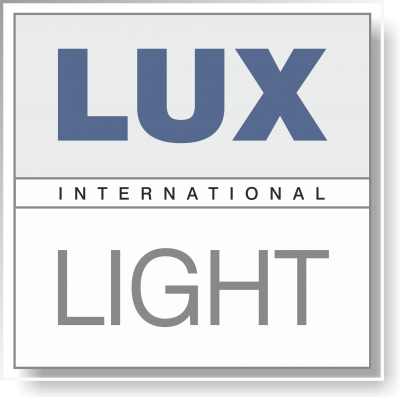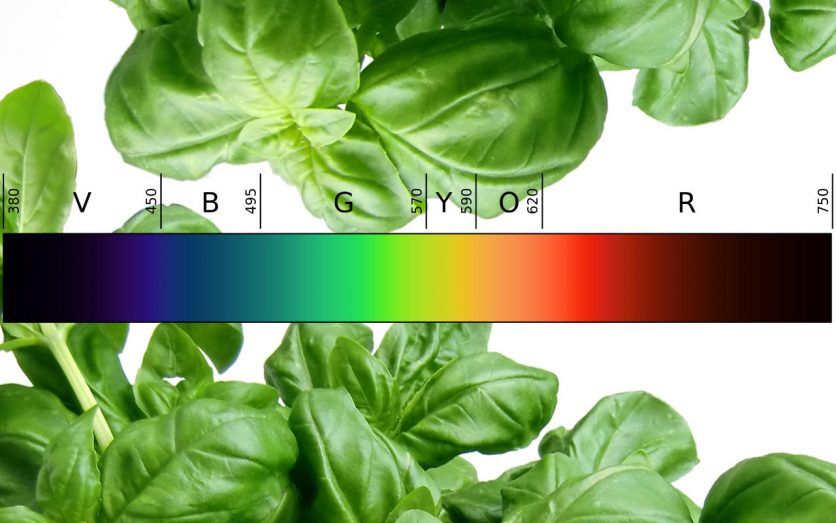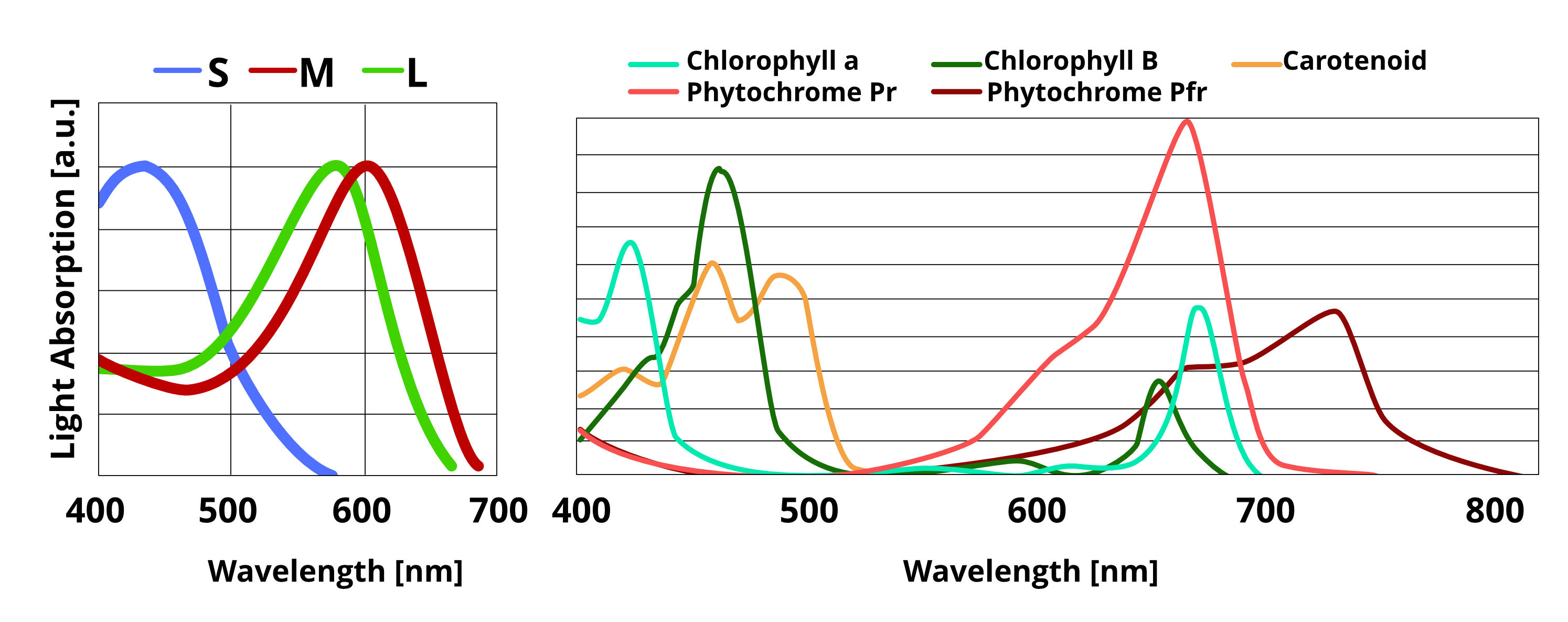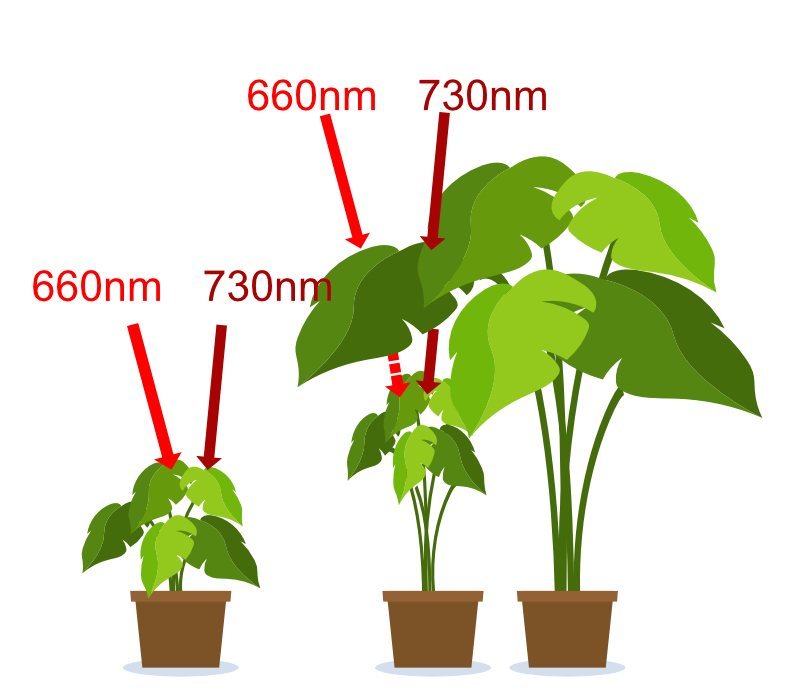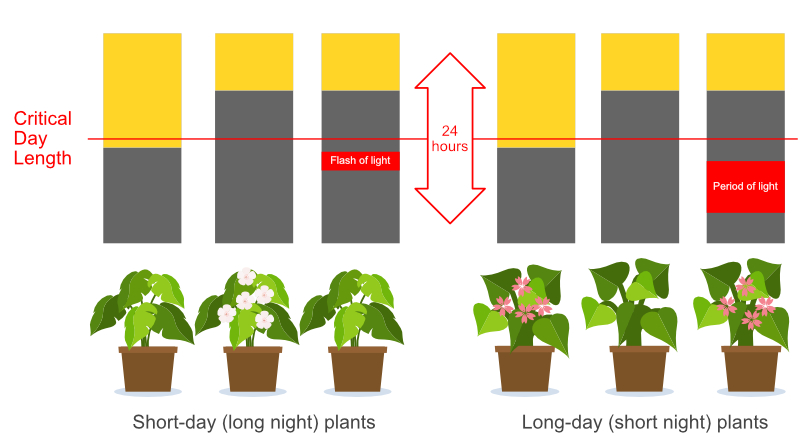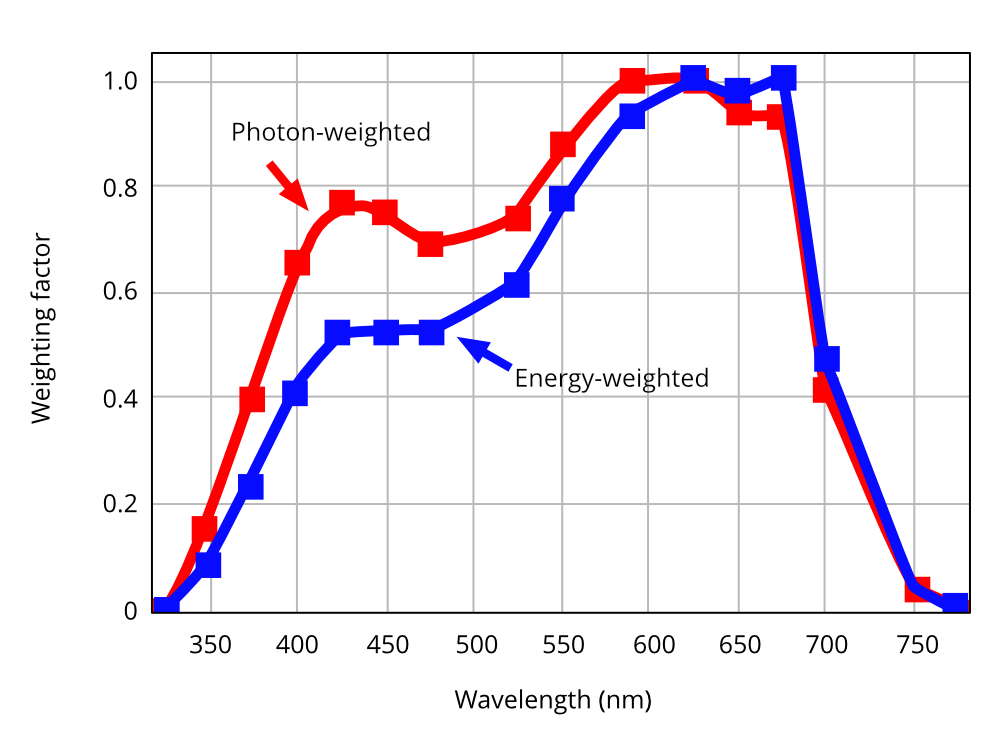Read the Previous Parts:
Part 1: Powering and cooling the LED fixture
Part 2: Heat Management, Optics and the body of the LED Fixture
Part3: LEDs – The Heart and Soul of the Fixture
Spectra – Feeding the Right Light
LED modules with a fixed spectrum have exactly this: one specific spectrum they provide. The user therefore will not be able to alter the spectrum to influence the growth of the plant.
On the plus side, you can be sure that you get exactly the PAR values that were measured with the emitted spectrum of the lamp.
On the other hand, you might have the wrong spectrum for the plant you are trying to grow which may influence the growth and amount of yield produced. (E.g., some strains of tomatoes grow better under LED lighting than others)
LED fixtures with a flexible spectrum let the user chose with which spectrum he wants to provide his plants. They mostly differ in spectra as “growth”, “bloom” and “work” (mostly white).
The biggest downside of these modules is that you can never be sure about the PAR values because these are always measured with every spectrum turned on, which never happens in an authentic growing environment. In addition, the grower has to know which spectrum to use during which phase and state of the plants.
This sounds easier than it actually is! For example, if you are in the flowering state, using the “bloom spectrum” and add the “growth spectrum” you may exceed the need of blue light for your plants.
This would result in smaller, more compact plants and less yield. With this in mind, a grower would use the “growth spectrum” for maybe two weeks – but he or she has to pay for a fixture that can handle all the LEDs and heat even if they are turned off.
As a rule of thumb: Do not buy anything you do not need! – do you really need the fixture or is it better to use a cheaper setup for growing (like Daylight LED tubes or bars) and a more professional fixture
for blooming? (This setup is often cheaper in total)
Systems that work with a modular spectrum offer the following: The user is able to adjust the spectrum by removing and replacing real hardware. Adding smaller LED systems to an existing bigger LED system makes it possible to provide plants with other spectra. With this setup you will never pay for light, spectra, LEDs, Drivers etc. you don’t use. You will just buy the stuff you need, plus you can fine tune your setup to your needs and wishes – this will result in higher yields of course.
EVERY LED on the horticultural market is technically dimmable.
This is important and even needed especially when working with smaller plants, which do not need as much output, or in many cases cannot even handle it.
The Quality of Light
A plant is able to recognize the light that surrounds it. It is able to differentiate intensity as well as color and quality of light. The plant adapts to the lighting conditions and regulates its growth depending to them. When grown in a dark environment, it develops long internodes and smaller leaves, which helps it, do grow nearer to a light source as fast as possible to escape bad lighting conditions.
When the plant is exposed to better light, the stretching reduces, leaves bend towards the light, expand and turn green. All of this makes the plant grow toward the light and maximize the chances of photosynthesis. The whole process is called photomorphogenesis.
The whole process is controlled by photoreceptors, which are light sensitive proteins. These proteins initiate signals, which lead to light responses. Each different receptor is sensitive to another wavelength and handles different responses of the plant. These receptors are activated by light; in darkness, they are not fulfilling any tasks. Some receptors also turn inactive when receiving photons from another wavelength, which means that they are not activated even though the plant gets enough light. This means the activation and deactivation of receptors can be controlled by the type of light you are feeding your plants because they can be very sensitive to specific changes in lighting.
How does the Plant Respond to Different Wavelengths?
Light is generating a photochemical reaction. In our eyes, it is reacting with the photoreceptor of different versions S, M and L (left scale).
Plants can use much more of the light spectrum than we see. They show reactions to different wavelengths with the help of Chlorophyll a and b, Phytochromes, Carotenoids etc (right scale).
As shown above, plants are able to use wavelengths and regions, which are not even visible to the human eye. In the following we are decrypting how the plants make use of these wavelengths and what parts are responsible for transforming light into usable energy for the plant.
Green Light
There is no receptor known that is specified on green light. Interestingly the addition of green lighting has shown increased plant growth rates. If this is a direct effect on the photosynthesis or whether
other factors are involved is not clear yet. Tests have shown that exposing seeds to green light makes the plants grow larger.
This althoughis not true for every plant and breed. Tomato seedlings for example are stunted in growth when provided with green light.
Hormones and Light
Because of photoreceptors, plants are able to optimize their morphology and physiology to match their surroundings. These changes and reactions to different lighting are mediated by the plants different hormones.
Chlorophyll a and b
The main function of chlorophyll is the absorption of light as well as transformation this into usable energy. Furthermore, it is responsible to redirecting this generated energy within the plant. This makes Chlorophyll molecules vital for the photosynthesis and therefore the ability to absorb energy from light as well as the production of oxygen as a secondary effect. Chlorophyll absorbs light most strongly in the blue region of the spectrum, followed by the red portion (see image 9). This is also the reason that plants appear green. They absorb the blue and red spectrum. When grown in the absence of light, plants appear rather pale because chlorophyll will stay inactive in light dependent plants when not they are not illuminated.
Carotenoid
The primary function of carotids during the photosynthesis of the plant is the protection of chlorophyll molecules. These would otherwise be destroyed by photo-oxidation. Furthermore they extend the absorption spectrum of the plant in the blue-green area. They are photosynthetic pigments, also known as antenna pigments, which absorb photons and redirect the energy to the photosynthetic reaction center.
Phytochrome
Phytochromes are mainly influencing germination, hypocotyl elongation, leaf expansion, flowering time circadian rhythm entrainment and chlorophyll biosynthesis. Plants are in possession of multiple types of phytochromes. They influence the plants responses to light by inducing changes in gene expressions. The most investigated phytochromes are phytochrome A (phyA) and B (phyB).
PhyB exists in its inactive state (Pr form) in complete darkness and the absorption of red light is the strongest (peak at 666nm). When the form Pr absorbs light, it gets activated and changes to the form Pfr. When this happens the absorption spectrum is redshifted so the maximal absorbance is in the far-red region (730nm).
When left in darkness, the Pfr shifts back to its inactive form. This can also be encouraged by absorption of light. PhyB cycles through these stages continuously in natural lighting environments. The spectrum controls whether the Pr or Pfr form dominates. PhyA is activated by far-red as well as red light and primarily accumulates in plant tissues in darkness.
Phytochromes absorb light of wavelengths all across the spectrum. Each other wavelength will create a slightly different ratio of Pr:Pfr. The photomorphogenic effects, such as seed germination and seedling development are controlled by applying a spectrum with a certain mix of 660nm and 730nm in order to stimulate the pr pfr phytochromes.
Illumination with Special Wavelengths
One of the most obvious influences of far-red light on a plant is the shade escape reaction. When the plant does not receive enough far-red, it tries to evade the shadow and therefore changes its morphology in specific ways. To illustrate the reactions of the plant we will look at the following circumstances.
If the plant is illuminated mainly with 660nm it feels like growing in direct sunlight. There are no special reactions because the plant does not have to adapt to certain circumstances. The growth is just as expected and there are no differences in morphology.
Now if the plant is illuminated with 730nm, it receives the same wavelength as growing in a shadow of another plant that shares the sun light. Therefore, the plant is reacting with an increased growth in length to escape the shadow. This leads to taller plants but not necessarily more bio mass.
Control of the Flowering by Illumination with Far-red
As shown before the plant reacts in certain ways to specific wavelengths. Also we saw how Red and Far-Red light mediate the conversion of photochromes, which can control the triggers for the flowering of the plant. With the illumination of a wavelength of 730nm the flowering of the plant can be easily controlled. This is how it works.
The cycle from Pr to Pfr is initiated by red light with a wavelength of 660nm, which represents daylight. During the night time, the Pfr is converted back to Pr. This back conversion can be actively influenced by 730nm far-red light. This enables a perfect control over the flowering timing independent of the seasons.
Control of the Flowering by Controlling the Critical Day Length with
any Light
Due to the influence of the Pr and Pfr ratio, the flowering can be controlled to adjust the timing to environmental or seasonal requirements.
As shown in the illustration (image 11), there are different types of plants: Short-day and long-day.
The yellow/grey bars indicate the duration of light and darkness in a time span of 24 hours. Short-day plants start their flowering during long nights (e.g. 6h of light, 18h of darkness).
A flash of light can interrupt the flowering and keep the plant in vegetation. Therefor the timing of the flowering can be timed when flashing the plant is cut out.
The Long-day plants on the other hand do not flower when supplied only with a short period of light, they like the shorter nights.
The flowering can be timed when supplying the plant with an additional period of light in their darkness period.
Additions on Wavelengths
Are PAR Values the Best Way to Show the Output of a LED Fixture?
The short answer would be: maybe not.
The problems that occur when using PAR values is that the whole spectrum is weighed equally by counting the photons in the photosynthetically active region (PAR) (μmol/s*m²).
However, what does it mean?
It means that every photon that has a wavelength between 400nm and 700nm is counted equally to the energy a plant can use. For example, a “green photon ~550nm” counts as much as a “red photon ~660nm” , but plants cannot get much energy out of a “green photon” because most of the green part of the light is reflected – this is why the plants are green.
A Better approach would be weighing the emission of the light source with plants’ spectral sensitivity curve (“plm/W”). This curve is derived from the chlorophyll absorption spectrum, taking into account internal energy transfer processes of the plant and its leaves.
This means that a “green photon” is not as usable for the plant as a “red photon” and this will lead to the consideration that far-red light 730nm is useful too!
Things to consider
The PAR values are for now new to the market, and not everybody understands the concept too well.
Introducing a new value to the market could do more harm than good by confusing people and make it harder to compare fixtures.
Nevertheless, once people get used to it, it could be the right thing to do.
Let us take a quick lookat wavelengths to see how they benefit your plant. Please keep in mind that different plants or genetics will react differently to a certain wavelength than others.
The UV (Ultraviolet) and IR (Infrared) Hoax
You may often see something like “UV Spectrum” LED, other advertisement regarding UV and IR spectra in a LED fixture.
Yes, there are LEDs on this earth which can emit UV light – no they are not in the LED fixture you chose to buy!
First of all what is UV light? UV Light is the spectrum of light below a wavelength of 400nm. This range of wavelengths then separates in different areas (see table 5).
This list shows one very important fact:
UV-“light” or UV-radiation begins at a wavelength below 400nm. If the “UV” is above 400nm it is called blue light.
UVB light
The atmosphere of the earth removes lots of radiation, which is emitted by the sun. This includes most of the UVB radiation nevertheless especially in the hot summer months UVB radiation is present and can cause damage to organisms.
Proteins, DNA and RNA can suffer severe damage by these rays. When UVB is present, to which plants are extremely sensitive, they produce a natural protection which is comparable to sunscreen. It is made of the production of a range of specific pigments and other secondary metabolites. The leaves and flowers will produce more intense colors due to this added pigmentation.
Furthermore plants develop a more robust growth and increase oil concentration in herbs. The UVB receptors are sensible to wavelengths between 280 and 330nm with a peak at 290nm.
⚠ ATTENTION ⚠
BE AWARE! Usage of lighting sources that emit UVB light can cause sunburn and skin cancer!Wear protection for eyes and skin or turn off supplemental UVB lighting when working in the growing environment.
Blue and UVA light
Plants have many blue light receptors, which can be divided into cryptochromes and phototropins. Phototropins influence cellular processes without altering genes. The cryptochromes on the other hand work in a way that they change the gene expression. Both react to the blue and UVA regions of the spectrum and cryptochromes are deactivated by green light.
Plants grown without feeding of blue light will end up etiolated and let their leaves hang downwards. LEDs with UVB radiation are very expensive at the moment but if you are in need for this, fluorescent tubes, like in tanning beds, can be used as a substitute pretty efficiently.
UV Light is often aimed to generate some resigns in certain plants – so, there is a use for this. But LED fixtures cannot generate this kind of spectrum for a reasonable price. Prices for one higher intensity UV Led chip are $26 and they will last for ~ 2000 – 4000h .
If you need cheap, good and reliable UV light, buy a tanning lamp for $5 that’s more than enough.
By the way, this applies to every light source – even for the “10.000K Chinese finishing lamps” it is not UV if the wavelength is above 400nm.
⚠ ATTENTION ⚠
Standard polycarbonate covers or lenses are not suitable for
long exposure to UV light
(e.g. UV radiation from the sun or the LED light source itself).The polycarbonate needs to be coated
or has to be chemically stabilized against this form of radiation.
Regarding IR light:
This is just another catch phrase to get the money from not trustful customers. But, let us see first where and what the IR wavelength is:
The “most far” wavelength a LED for Horticulture can reliably produce is 730nm (FAR RED). In addition, that is in the visible red range, not IR! If you need this kind of light – HPS lamps can produce this at a much cheaper price.
Need Further Information or Professional Advice?
At Lux Light International we are experts in the area of professional
horticultural lighting. If you have further or more specific questions,
feel free to contact us at any time.
With over 25 years of experience we will help you to achieve the
optimum setup for your growing needs.
Contact us at:
Web: www.luxlight.de
Mail: [email protected]
Phone: +49 (0) 6421 – 8891 40
